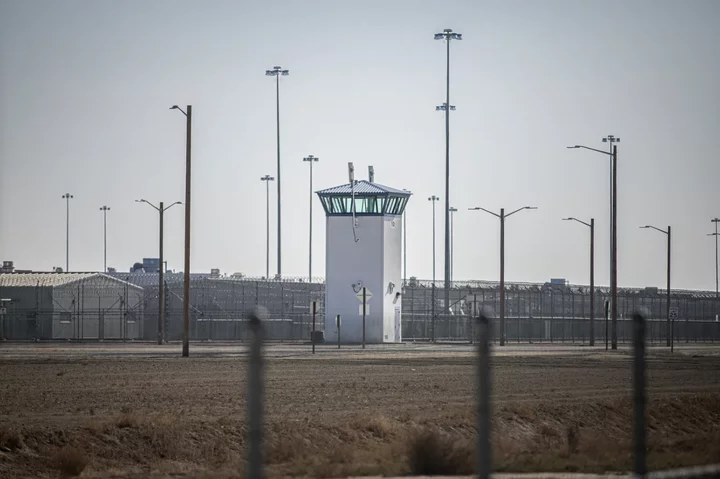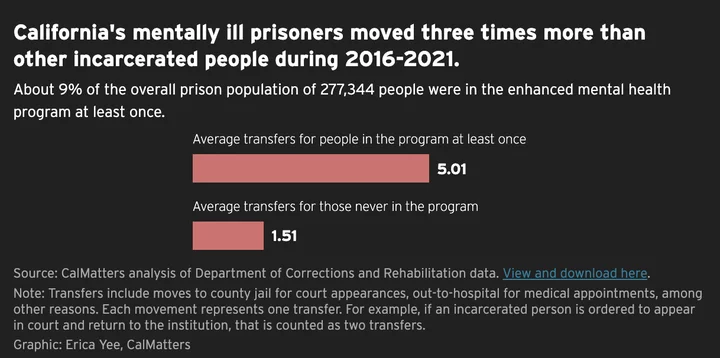A guard tower at Kern Valley State Prison on Nov. 15, 2022. Photo by Larry Valenzuela, CalMatters/CatchLight Local
California state prisons transfer people with serious mental illness far more frequently than other prisoners — sometimes moving them dozens of times — a CalMatters’ analysis of newly acquired state data has found.
The findings underscore a CalMatters’ investigation from earlier this year which revealed the state’s practice of shuffling around mentally ill prisoners, which some advocates say can be disruptive and damaging to these vulnerable people.
The story focused on the case of Adam Collier, who had been diagnosed with post-traumatic stress disorder, bipolar disorder, borderline personality disorder and anxiety disorder, among other mental illnesses. Collier was serving a five-year sentence for exposing himself to women in public while high on meth. He was moved 39 times between 2016 and 2020 — bouncing among crisis units, state hospitals and seven different prisons — before he killed himself in Kern Valley State Prison in October 2020.
CalMatters’ analysis of data from the California Department of Corrections and Rehabilitation found that, from 2016 to 2021, California prisoners in “enhanced outpatient” mental health treatment were moved three times more often, on average, than other prisoners.
The data shows that incarcerated people in the system’s enhanced mental health program — which provides the highest level of outpatient mental health care for prisoners — averaged five moves during the time period, compared to an average 1.5 transfers for people in the general prison population.
One person, who was in and out of the mental health program, moved 75 times during the six-year period. The data does not identify any individuals.
“That doesn’t surprise me at all,” said Keramet Reiter, a criminology professor at the University of California, Irvine. “The seriously mentally ill people … bounce around a bit.”
CalMatters had requested the state’s transfers data on March 31; the department responded on Aug. 1 and Sept. 16. For its June story, CalMatters collected its own data about prison transfers for about a year, which generally mirrors the state’s records during the same timeframe.
“Transfers for an inmate are disruptive,” said Christopher Lisieski, the attorney representing Collier’s mother in a federal lawsuit against several prison employees. “Disrupting someone’s routine who’s severely mentally ill is additional stress and strain and can worsen mental health symptoms.”
Advocates, prisoners and family members contend that, in cases like Collier’s, a steady stream of transfers reflects a system that too often fails to adequately care for people in mental health crises. These incarcerated people might bounce between prisons and short-term crisis beds without ever stabilizing enough to get better, they say.
In California, mental health care in state prisons is designed so that incarcerated people transfer to appropriate levels of care as their needs change. Treatments range from outpatient therapy in the general prisoner population to long-term hospitalization in treatment facilities within the correctional system.
Prisoners needing the highest level of care could be sent to state hospitals, which are separate facilities that also house people who are not in the criminal justice system.
But the system doesn’t always work perfectly. In several investigations, the Inspector General has determined that people who need it sometimes aren’t referred to a higher level of care.
In other cases, experts say, multiple transfers can mean the system is working and people are getting the care they need.
Department spokesperson Dana Simas wrote in an emailed statement that the state transfers prisoners for a variety of reasons, including court hearings, medical treatment, mental health treatment, changes in security level, patient safety, staff conflicts, misconduct allegations or parole.
In California, prison mental health treatment policies are governed by a federal class-action lawsuit — known as Coleman — on behalf of prisoners with serious mental illness.
In 1995, a federal court ruled that the department was not providing adequate mental health care to prisoners. The court eventually approved the Corrections Department’s plan for providing mental health care and appointed a special master to monitor and report on the state’s compliance.
“The department works closely with the Coleman special master and others on these matters, and always strives for what is in the best interest of the patient’s individual needs,” Simas wrote in an email to CalMatters.
Special master Matthew A. Lopes Jr. did not respond to CalMatters’ request for comment.
 A family photo of Adam Collier. Photo courtesy of Susan Ottele
A family photo of Adam Collier. Photo courtesy of Susan Ottele
In Collier’s case, he moved so frequently that his mother, Susan Ottele of McMinnville, Ore., started “every single, solitary day” checking online to see which prison was holding Collier and why.
When the pandemic hit, the prisons went on lockdown, and Collier sat inside Kern Valley State Prison for seven months. It was his longest stay at any prison since 2016.
“With all these transfers, I’m fucking dizzy,” Collier wrote in a letter to Ottele in March 2020. Months later, at age 43, Collier killed himself.
The Office of the Inspector General investigated Collier’s suicide and found that the department had “poorly handled” Collier’s case. The inspector general’s March 2021 report described an array of internal problems, including clinicians improperly delaying Collier’s referral to a higher level of care and failing to adequately document his history of self-harm.
Earlier this year, Ottele filed a wrongful death complaint in federal court, alleging that prison guards failed to monitor her son and acted with deliberate indifference.
In court documents, state attorneys deny these claims, saying the guards were not aware of Collier’s history of suicide attempts. The Department of Corrections and Rehabilitation declined to comment on the lawsuit, citing pending litigation. Lisieski, Ottele’s attorney, said the case likely won’t be resolved for years.
###
CalMatters.org is a nonprofit, nonpartisan media venture explaining California policies and politics.


CLICK TO MANAGE